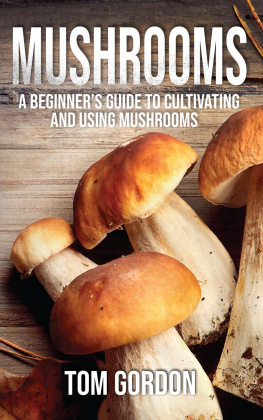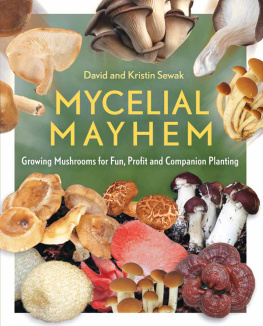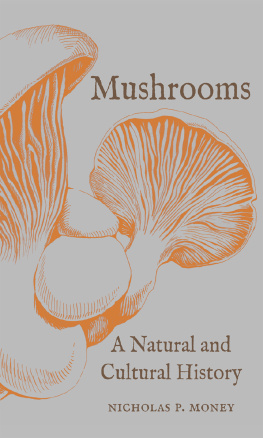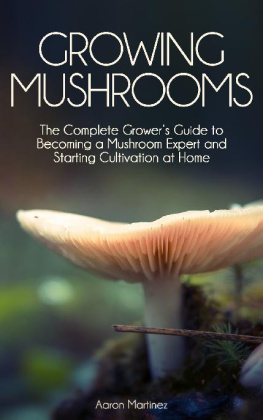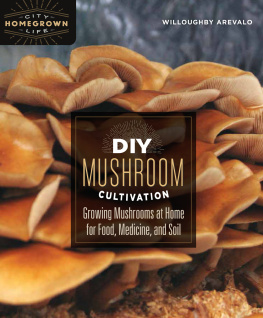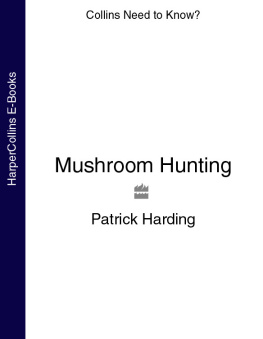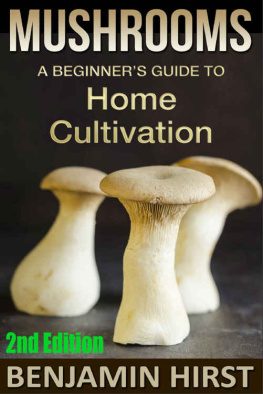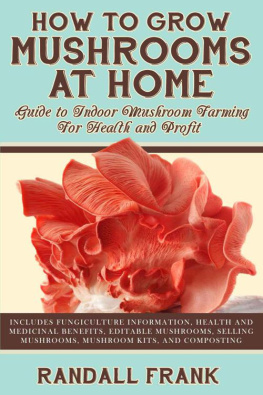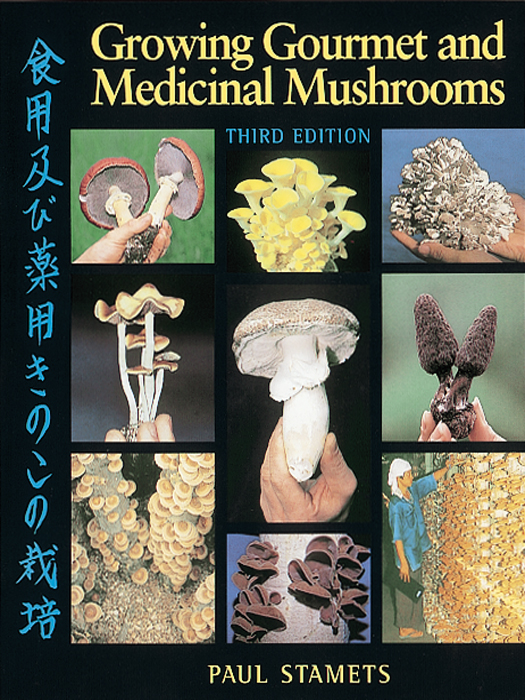
This book should help advance the cause of mycology and mushroom biology worldwide. It will be an important reference for those who are interested in research as well as in the cultivation of mushrooms. Growing Gourmet and Medicinal Mushrooms is unique not only in its treatment of the technical aspects of growing gourmet and medicinal mushrooms, but also in its emphasis on the environmental importance of mushrooms in terms of world biological diversity.
S. T. Chang, Ph.D., The Chinese University of Hong Kong
Growing Gourmet and Medicinal Mushrooms is a visionary questand Paul Stamets is your best possible guidenot just for informing you about growing mushrooms, but for transforming you into a myco-warrior, an active participant in a heroic, Gaian process of planetary health through mushroom cultivation.
Gary Lincoff, author of The Audubon Field Guide to Mushrooms
Stamets draws on the collective experience of centuries of mushroom cultivation, creating a revolutionary model for the use of higher fungi. Not only does he cover every aspect of cultivation, he also addresses the issues of environmentalism, health, and business.
Alan Bessette, Ph.D., Utica College of Syracuse University
Growing Gourmet and Medicinal Mushrooms is the most comprehensive treatment of the subject I have seen in my thirty years as a mycologist and mushroom specialist.
S. C. Jong, Ph.D., The American Type Culture Collection
Pick up this book and prepare to be swept away into the world of mushroom cultivation on the tide of Pauls contagious enthusiasm. Doers and dreamers, students and teachers will all find something to enjoy in this book.
Nancy Smith Weber, Ph.D., Forest Sciences Department, Oregon State University
This book, a true labor of love, makes a major contribution to our knowledge of the practical production of gourmet and medicinal mushrooms.
Dan Royse, Ph.D., Penn State College of Agricultural Sciences

Copyright 1993, 2000 by Paul Stamets
All rights reserved. Published in the United States by Ten Speed Press, an imprint of
the Crown Publishing Group, a division of Random House, Inc., New York.
www.crownpublishing.com
www.tenspeed.com
Ten Speed Press and the Ten Speed Press colophon are registered trademarks of Random House, Inc.
Photograph of Chinese rank badge (Wild Goose, 4th Rank) on courtesy of Beverley Jackson.
Cover design by Andrew Lenzer and Jeff Brandenburg
Interior design by Jeff Brandenburg
Library of Congress Cataloging-in-Publication Data
Stamets, Paul.
Growing gourmet and medicinal mushrooms = [Shokuyo oyobi yakuyo kinoko no saibai] : a companion guide to The Mushroom Cultivator / by Paul Stamets. 3rd ed.
p. cm.
Includes bibliographical references (p.).
eISBN: 978-1-60774-138-1
1. Mushroom culture. I. Title: Growing gourmet and medicinal mushrooms. II. Title: Shokuyo oyobi yakuyo kinoko no saibai.
SB353.S73 2000
635.8-dc21 00-042584
v3.1
Mycotopia:
An environment wherein ecological equilibrium is enhanced through the judicious use of fungi for the betterment of all lifeforms.
To my family
and
the Warriors of Hwa Rang Do
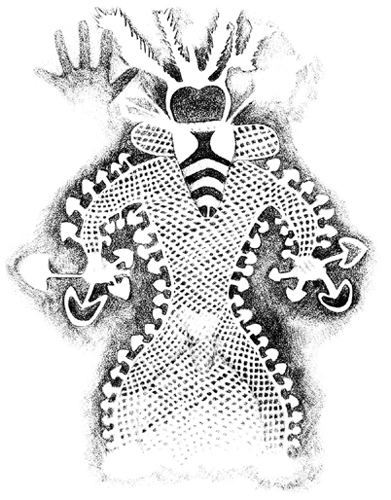
Contents
Mushroomsfleshy fungiare the premier recyclers on the planet. Fungi are essential to recycling organic wastes and the efficient return of nutrients back into the ecosystem. Not only are they recognized for their importance within the environment, but also for their effect on human evolution and health. Yet, to date, the inherent biological power embodied within the mycelial network of mushrooms largely remains a vast, untapped resource. As we begin the twenty-first century, ecologists, foresters, bioremediators, pharmacologists, and mushroom growers are converging at a new frontier of knowledge, wherein enormous biodynamic forces are at play.
Only recently have we learned enough about the cultivation of mushrooms to tap into their inherent biological power. Working with mushroom mycelium en masse will empower every country, farm, recycling center, and individual with direct economic, ecological, and medical benefits. Through the genius of evolution, the Earth has selected fungal networks as a governing force managing ecosystems. This sentient network responds quickly to catastrophia. I believe the mycelium is Earths natural Internet, a neural network of communicating cells. All landmasses are criss-crossed with interspersing mosaics of mycelial colonies. With more than a mile of cells in a cubic inch of soil, the fungi are moving steadily, although silently all around us. This vast mass of cells, in the hundreds of billions of tons, represents a collective intelligence, like a computer honed to improve itself. Only now are scientists discovering that it is the microbial community upon which all higher life forms are dependent. And only now do we know how to join in alliance with them to improve life. As we begin a new century, myco-technology is a perfect example of the equation of good environmentalism, good health, and good business.
This book strives to create new models for the future use of higher fungi in the environment. As woodland habitats, especially old growth forests, are lost to development, mushroom diversity also declines. Wilderness habitats still offer vast genetic resources for new strains. The temperate forests of North America, particularly the mycologically rich Pacific Northwest, may well be viewed in the twenty-first century as pharmaceutical companies viewed the Amazon Basin earlier in the twentieth century. Hence, mushroom cultivators should preserve this gene pool now for its incalculable, future value. The importance of many mushroom species may not be recognized for decades to come.
In many ways, this book is an offspring of the marriage of many cultures arising from the worldwide use of mushrooms as food, as religious sacraments in Mesoamerica, and as medicine in Asia. We now benefit from the collective experience of lifetimes of mushroom cultivation. As cultivators we must continue to share, explore, and expand the horizons of the human/fungal relationship. In the future, humans and mushrooms must bond in an evolutionary partnership. By empowering legions of individuals with the skills of tissue culture and mycelial management, future generations will be able to better manage our resources and improve life on this planet.
Now that the medical community widely recognizes the health-stimulating properties of mushrooms, a combined market for gourmet and medicinal foods is rapidly emerging. People with compromised immune systems would be wise to create their own medicinal mushroom gardens. I envision the establishment of a community-based, resource-driven industry, utilizing recyclable materials in a fashion that strengthens ecological equilibrium and human health. As recycling centers flourish, their by-products include streams of organic waste, which cultivators can divert into mushroom production.
I foresee a network of environmentally sensitive and imaginative individuals presiding over this new industry, which has previously been controlled by a few mega-businesses. The decentralization began with


